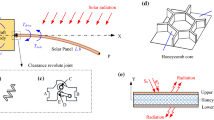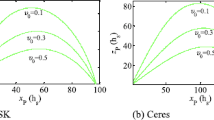Abstract
The solar sail is one of the most promising space exploration systems due to its theoretically infinite specific impulse achieved through solar radiation pressure (SRP). Recently, researchers have proposed “transformable spacecraft” capable of actively reconfiguring their body configurations using actuatable joints. Transformable spacecraft, if used similarly to solar sails, are expected to significantly enhance orbit and attitude control capabilities owing to their high redundancy in control degrees of freedom. However, controlling them becomes challenging due to their large number of inputs, leading previous researchers to impose strong constraints to limit their potential control capabilities. This study focuses on novel attitude control techniques for transformable spacecraft under SRP. We developed two methods, namely, joint angle optimization to obtain arbitrary SRP force and torque, and momentum damping control driven by joint angle actuation. Our proposed methods are formulated in a general manner and can be applied to any transformable spacecraft comprising front faces that can predominantly receive the SRP on each body. The validity of our proposed method is confirmed through numerical simulations. Our study contributes to making most of the high control redundancy of transformable spacecraft without the need for expendable propellants, thus significantly enhancing the orbit and attitude control capabilities.

Similar content being viewed by others
Abbreviations
- C :
-
Direction cosine matrix
- C spe, C dif, C abs :
-
Coefficient of optical properties
- CoM:
-
Center of mass
- d :
-
Second-order term of a generalized velocity
- F :
-
SRP force (N)
- h c :
-
Angular momentum around the CoM of whole bodies (kg · m2/s)
- I x :
-
Moment of inertia of X around the CoM of X (kg · m2)
- m X :
-
Total mass of X (kg)
- M :
-
Generalized mass matrix
- n i :
-
Normal vector of the i-th body
- P :
-
SRP (Pa)
- Q, R :
-
Weight matrices for linear quadratic regulator (LQR)
- r X (= R X − R 0):
-
Relative position of the CoM of X with respect to the CoM of body 0 (m)
- r XY(= R x − R Y):
-
Relative position of the CoM of X with respect to the CoM of Y (m)
- R x :
-
Absolute position of the CoM of body X (m)
- s :
-
Sun pointing vector
- t :
-
Time (s)
- T:
-
SRP torque (N·m)
- U :
-
Identity matrix
- v :
-
Generalized velocity
- w :
-
Generalized acceleration
- x × :
-
Skew symmetric matrix of a vector x ∈ ℝ3
- θ(= [θ 1, ⋯, θ m]T):
-
Joint angle vector (rad)
- θ k :
-
Angular displacement of the k-th actuatable joint (rad)
- λ k :
-
Rotational axis of the k-th joint
- τ :
-
Generalized force
- ϕ(= [ϕ 1, ϕ 2, ϕ 3]T):
-
Euler angles (rad)
- ω :
-
Angular velocity of body 0 (rad/s)
- c :
-
Subscript which signifies the whole bodies
- hk :
-
Subscript which signifies the k-th joint
- k :
-
Subscript which signifies the k-th body
- k̂ :
-
Subscript which signifies the k-th outer group
- s ij :
-
subscript which signifies the j-th surface of the i-th body
References
Sauer, C. Optimum solar-sail interplanetary trajectories. In: Proceedings of the Astrodynamics Conference, San Diego, CA, USA, 1976: AIAA 1976-792.
Leipold, M., Wagner, O. “Solar photonic assist” trajectory design for solar sail missions to the outer solar system and beyond. In: Spaceflight Dynamics 1998. Volume 100 Pari II of the Advances in the Astronautical Sciences Series. 1998. Information on https://elib.dlr.de/18046/
McInnes, C. R., McDonald, A. J. C., Simmons, J. F. L., MacDonald, E. W. Solar sail parking in restricted three-body systems. Journal of Guidance, Control, and Dynamics, 1994, 17(2): 399–406.
Baoyin, H. X., McInnes, C. R. Solar sail halo orbits at the Sun–Earth artificial L1 point. Celestial Mechanics and Dynamical Astronomy, 2006, 94(2): 155–171.
Ono, G., Tsuda, Y., Akatsuka, K., Saiki, T., Mimasu, Y., Ogawa, N., Terui, F. Generalized attitude model for momentum-biased solar sail spacecraft. Journal of Guidance, Control, and Dynamics, 2016, 39(7): 1491–1500.
Tsuda, Y., Ono, G., Mimasu, Y. Classification of solar sail attitude dynamics with and without angular momentum. Astrodynamics, 2019, 3(3): 207–216.
Liu, J. F., Cui, N. G., Shen, F., Rong, S. Y., Wen, X. Dynamic modeling and analysis of a flexible sailcraft. Advances in Space Research, 2015, 56(4): 693–713.
Liu, J. F., Chen, L. Q., Cui, N. G. Solar sail chaotic pitch dynamics and its control in Earth orbits. Nonlinear Dynamics, 2017, 90(3): 1755–1770.
Mori, O., Sawada, H., Funase, R., Morimoto, M., Endo, T., Yamamoto, T., Tsuda, Y., Kawakatsu, Y., Kawaguchi, J., Miyazaki, Y., et al. First solar power sail demonstration by IKAROS. Transactions of the Japan Society for Aeronautical and Space Sciences, Aerospace Technology Japan, 2010, 8(27): To_4_25–To_4_31.
Tsuda, Y., Mori, O., Funase, R., Sawada, H., Yamamoto, T., Saiki, T., Endo, T., Kawaguchi, J. Flight status of IKAROS deep space solar sail demonstrator. Acta Astronautica, 2011, 69(9–10): 833–840.
Spencer, D. A., Betts, B., Bellardo, J. M., Diaz, A., Plante, B., Mansell, J. R. The LightSail 2 solar sailing technology demonstration. Advances in Space Research, 2021, 67(9): 2878–2889.
Takao, Y., Chujo, T., Mori, O., Kawaguchi, J. Active shape control of spinning membrane space structures and its application to solar sailing. Transactions of the Japan Society for Aeronautical and Space Sciences, 2018, 61(3): 119–131.
Takao, Y., Mori, O., Kawaguchi, J. Optimal interplanetary trajectories for spinning solar sails under sail-shape control. Journal of Guidance, Control, and Dynamics, 2019, 42(11): 2541–2549.
Takao, Y., Mori, O., Kawaguchi, J. Self-excited oscillation of spinning solar sails utilizing solar radiation pressure. Astrodynamics, 2020, 4(3): 177–192.
Nakamura, Y., Mukherjee, R. Nonholonomic path planning of space robots via bi-directional approach. In: Proceedings of the IEEE International Conference on Robotics and Automation, Cincinnati, OH, USA, 2002: 1764–1769.
Papadopoulos, E. G. Path planning for space manipulators exhibiting nonholonomic behavior. In: Proceedings of the IEEE/RSJ International Conference on Intelligent Robots and Systems, Raleigh, NC, USA, 2002: 669–675.
Murray, R. M., Sastry, S. S. Nonholonomic motion planning: Steering using sinusoids. IEEE Transactions on Automatic Control, 1993, 38(5): 700–716.
Ohashi, K., Chujo, T., Kawaguchi, J. Optimal motion planning in attitude maneuver using non-holonomic turns for a transformable spacecraft. In: Proceedings of the 2018 AAS/AIAA Astrodynamics Specialist Conference, 2018: 2735–2745.
Gong, S. P., Gong, H. R., Shi, P. Shape-based approach to attitude motion planning of reconfigurable spacecraft. Advances in Space Research, 2022, 70(5): 1285–1296.
Kubo, Y., Kawaguchi, J. Approximate analytical solution for attitude motion of a free-flying space robot and analysis of its nonholonomic properties. Transactions of the Japan Society for Aeronautical and Space Sciences, Aerospace Technology Japan, 2022, 20: 35–40.
Kubo, Y., Kawaguchi, J. Nonholonomic reorientation of free-flying space robots using parallelogram actuation in joint space. Journal of Guidance, Control, and Dynamics, 2022, 45(7): 1299–1309.
Chujo, T. Propellant-free attitude control of solar sails with variable-shape mechanisms. Acta Astronautica, 2022, 193: 182–196.
Abrishami, A., Gong, S. P. Optimized control allocation of an articulated overactuated solar sail. Journal of Guidance, Control, and Dynamics, 2020, 43(12): 2321–2332.
Gong, H. R., Gong, S. P., Liu, D. L. Attitude dynamics and control of solar sail with multibody structure. Advances in Space Research, 2022, 69(1): 609–619.
Kubo, Y., Chujo, T., Mori, O., Sugihara, K., Ahmed, Tetsuya, K., Masahiro, F., Junichiro, K., Yoshiki, S. Preliminary study on system and mission sequence design for Transformer mission. In: Proceedings of the 73rd International Astronautical Congress, International Astronautical Federation, 2022. Information on https://dl.iafastro.directory/event/IAC-2022/paper/73684/
Miyamoto, K., Chujo, T., Watanabe, K., Matunaga, S. On-orbit verification of attitude dynamics of satellites with variable shape mechanisms using atmospheric drag torque and gravity gradient torque. In: Proceedings of the AIAA SCITECH 2023 Forum, National Harbor, MD, USA & Online, 2023: AIAA 2023-0933.
Chujo T, Kubo Y, Kobayashi H, Sugawara Y. Orbit-attitude integrated control on small-amplitude periodic orbit around Sun–Earth L2 in Transformer mission. In: Proceedings of the 73rd International Astronautical Congress, International Astronautical Federation, 2022. Information on https://dl.iafastro.directory/event/IAC-2022/paper/73413/
Kubo, Y. Simultaneous body reconfiguration and nonholonomic attitude reorientation of free-flying space robots. Ph.D. Dissertation. Tokyo, Japan: The University of Tokyo, 2022.
Kane, T. R., Levinson, D. A. The use of Kane’s dynamical equations in robotics. The International Journal of Robotics Research, 1983, 2(3): 3–21.
Kane, T. R., Levinson, D. A. Dynamics, Theory and Applications. New York: McGraw Hill, 1985.
McInnes, C. R. Solar Sailing: Technology, Dynamics and Mission Applications. Berlin, Germany: Springer Science & Business Media, 2004.
Byrd, R. H., Hribar, M. E., Nocedal, J. An interior point algorithm for large-scale nonlinear programming. SIAM Journal on Optimization, 1999, 9(4): 877–900.
Kubo, Y., Chujo, T., Kawaguchi, J. Propellant-free station keeping around Sun–Earth L2 using solar radiation pressure for a transformable spacecraft. In: Proceedings of the 32nd International Symposium on Space Technology and Science, 2019.
Kalman, R. E. Contributions to the theory of optimal control. Boletin de la Sociedad Matematica Mexicana, 1960, 5(2): 102–119.
Yamada, K. Handbook of Spacecraft Dynamics and Control: From Fundamental Theory to Applied Technologies. Tokyo, Japan: Baifukan, 2007: 152–195, 868–898. (in Japanese)
Acknowledgements
This study was supported by the Advisory Committee for Space Engineering in Japan as a strategic research group. The authors are grateful to the members of the Transformer working group, who greatly enhanced the value of the present study through thorough and patient discussions.
Author information
Authors and Affiliations
Corresponding author
Ethics declarations
The authors have no competing interests to declare that are relevant to the content of this article.
Additional information
Yuki Kubo received his Ph.D. degree in aeronautics and astronautics from the University of Tokyo, Japan, in 2022. He is currently a research associate at Institute of Space and Astronautical Science, JAXA. His research interests include space robotics, astrodynamics, nonholonomic mechanics, spacecraft system, and deep-space exploration. E-mail: kubo.yuki@jaxa.jp
Toshihiro Chujo received his Ph.D. degree in engineering from the University of Tokyo, Japan, in 2017. He is currently an assistant professor at Tokyo Institute of Technology. His main field of study includes astrodynamics, space mission design, spacecraft system, especially for solar sails. E-mail: chujo.t.aa@m.titech.ac.jp
Rights and permissions
About this article
Cite this article
Kubo, Y., Chujo, T. Optimization of body configuration and joint-driven attitude stabilization for transformable spacecraft under solar radiation pressure. Astrodyn 8, 47–60 (2024). https://doi.org/10.1007/s42064-023-0167-3
Received:
Accepted:
Published:
Issue Date:
DOI: https://doi.org/10.1007/s42064-023-0167-3




